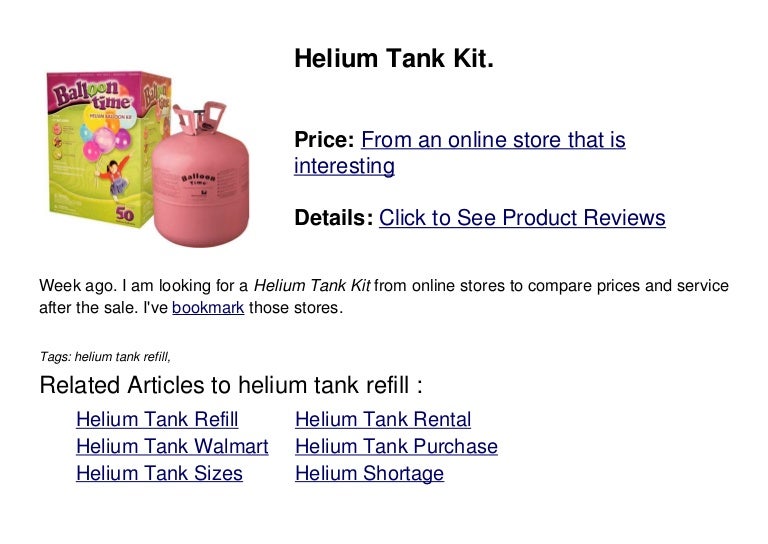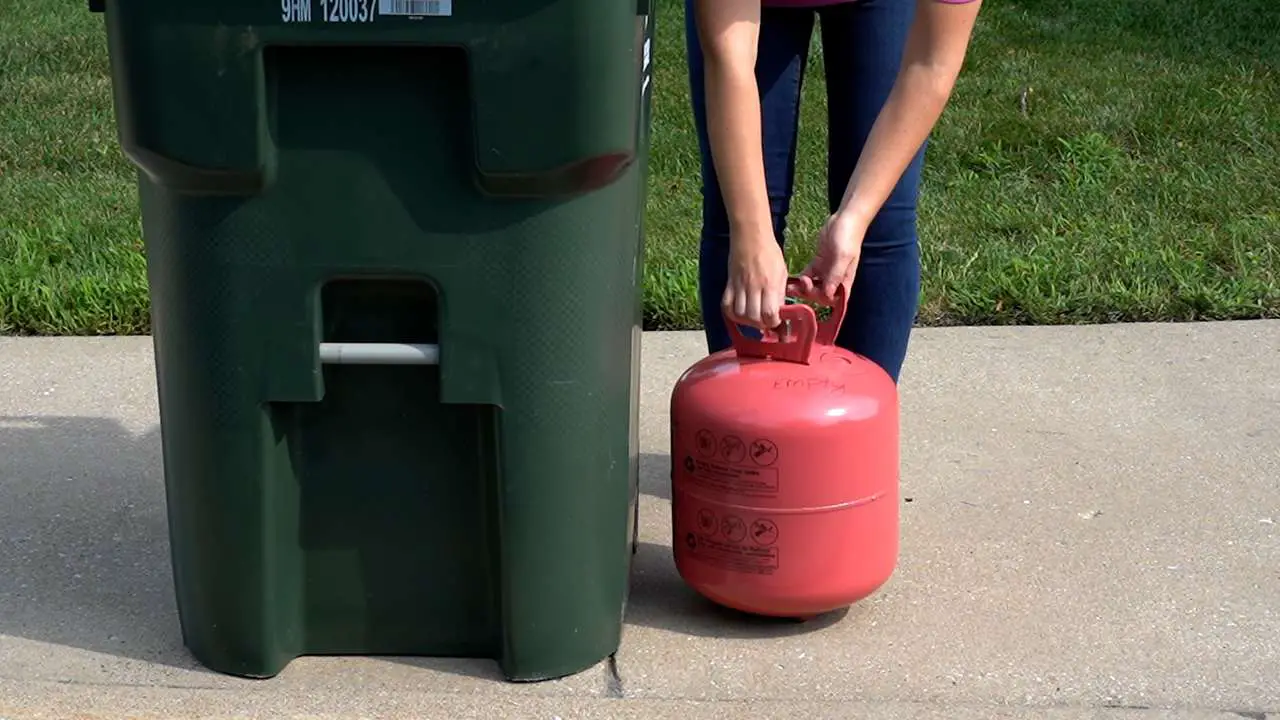How Do You Refill A Helium Tank

Have you ever planned a party, meticulously gathering balloons, only to discover your helium tank is disappointingly empty? Refilling a helium tank might seem daunting, but with the right knowledge and precautions, it can be a manageable task. However, unlike fixing a faulty toaster, directly refilling standard consumer helium tanks isn't always the safest or most practical DIY endeavor. This article will guide you through understanding your options and safely managing your helium supply.
Understanding Your Helium Tank Options
Before diving into any "refilling" process, it's crucial to understand the type of helium tank you have and the associated risks. Most consumer-grade helium tanks are disposable, designed for single use and not intended for refilling at home. Attempting to refill these can be dangerous due to pressure concerns and potential leaks.
Types of Helium Tanks
- Disposable Helium Tanks: These are the most common type for small parties and events. They are lightweight and relatively inexpensive but cannot be safely refilled using DIY methods.
- Refillable Helium Tanks: These are typically larger, more robust tanks used by professionals or for frequent balloon inflation. They have valves and fittings specifically designed for refilling. These are typically rented from gas suppliers.
Why You Can't (Safely) Refill Disposable Helium Tanks
Disposable helium tanks are thin-walled and not designed to withstand the pressure of refilling. Attempting to refill them can lead to:
- Tank Rupture: The tank could explode under pressure, causing serious injury.
- Valve Failure: The valve could leak or fail, releasing helium rapidly.
- Improper Sealing: Even if you manage to add helium, the tank may not seal properly, leading to leaks and wasted helium.
It is strongly advised against attempting to refill disposable helium tanks due to safety risks.
Managing Your Helium Supply: Practical Alternatives
Instead of risking a dangerous refill attempt, here are safer and more practical alternatives for managing your helium needs:
- Rent a Refillable Tank: If you need helium frequently, renting a refillable tank from a gas supplier is the safest and most cost-effective option.
- Purchase a Larger, Refillable Tank (Considerations): Buying a large helium tank is an option if you use a significant amount of helium regularly. However, consider the storage space required and the costs associated with refilling the tank through a professional supplier. Also, consider the lifespan and safety of storing compressed gas.
- Use Air Pumps for Balloons: For many decorations, air-filled balloons can be a viable alternative to helium balloons. Air pumps are inexpensive and easy to use.
- Consider Balloon Alternatives: Explore alternative decorations that don't require helium, such as streamers, banners, or paper lanterns.
If You Have a Refillable Helium Tank: The Refilling Process (General Overview - Still Requires Professional Expertise)
This section provides a general overview. Always consult the tank manufacturer's instructions and local regulations before attempting to refill a refillable helium tank. It is highly recommended to have a professional handle this process.
Step 1: Safety First!
- Wear Safety Gear: Always wear safety glasses and gloves when handling helium tanks.
- Ensure Proper Ventilation: Refill the tank in a well-ventilated area to prevent helium buildup.
- Inspect the Tank: Carefully inspect the tank for any signs of damage, such as dents, rust, or leaks. Do not attempt to refill a damaged tank.
Step 2: Gather Your Supplies (Professionally Sourced)
- Refillable Helium Tank: Ensure your tank is designed for refilling and in good condition.
- Helium Supply Cylinder: This is a large cylinder of compressed helium, typically obtained from a gas supplier.
- Regulator: A pressure regulator is essential for controlling the flow of helium from the supply cylinder to your refillable tank. It ensures that you don't overfill the tank.
- Connecting Hose: A high-pressure hose is used to connect the regulator to the valve on your refillable tank.
- Wrench: A wrench may be needed to tighten connections securely.
Step 3: Connect the Regulator
- Attach the Regulator to the Helium Supply Cylinder: Carefully screw the regulator onto the valve of the helium supply cylinder. Ensure the connection is tight to prevent leaks. Use a wrench if necessary.
- Connect the Hose to the Regulator: Attach one end of the high-pressure hose to the outlet fitting on the regulator. Tighten the connection securely.
Step 4: Connect the Hose to the Refillable Tank
- Locate the Fill Valve: Identify the fill valve on your refillable helium tank.
- Connect the Hose: Connect the other end of the high-pressure hose to the fill valve. Tighten the connection securely.
Step 5: Slowly Open the Valves
- Open the Helium Supply Cylinder Valve Slowly: Gradually open the valve on the helium supply cylinder. Watch the pressure gauge on the regulator.
- Adjust the Regulator: Adjust the regulator to the recommended pressure for filling your refillable tank. Consult the tank manufacturer's instructions for the correct pressure. Do not exceed the maximum pressure rating of the tank.
- Open the Fill Valve on the Refillable Tank: Slowly open the fill valve on the refillable tank to allow helium to flow in.
Step 6: Monitor the Pressure
- Watch the Pressure Gauge: Carefully monitor the pressure gauge on your refillable tank. Stop filling when the tank reaches its maximum pressure rating.
- Listen for Leaks: Listen for any hissing sounds that might indicate a leak. If you hear a leak, immediately close all valves and address the issue before proceeding.
Step 7: Close the Valves and Disconnect
- Close the Fill Valve: Once the tank is full, close the fill valve on the refillable tank.
- Close the Helium Supply Cylinder Valve: Close the valve on the helium supply cylinder.
- Bleed the Hose: Carefully bleed any remaining helium from the hose by slightly loosening the connection at the refillable tank. This will release the pressure in the hose.
- Disconnect the Hose: Disconnect the hose from the refillable tank and the regulator.
- Remove the Regulator: Remove the regulator from the helium supply cylinder.
Step 8: Check for Leaks (Important!)
- Soap and Water Test: Mix a solution of soap and water and apply it to all connections on the refillable tank. Look for bubbles, which indicate a leak.
- Address Leaks: If you find any leaks, tighten the connections or replace any damaged parts. If you cannot fix the leak, do not use the tank and consult a professional.
Troubleshooting Common Helium Tank Issues (Refillable Tanks)
Even with proper procedures, you might encounter some issues. Here's a quick troubleshooting guide for refillable helium tanks (again, emphasizing the need for professional assistance when unsure):
- Tank Not Filling:
- Check the Helium Supply Cylinder: Ensure the supply cylinder is not empty.
- Check the Regulator: Make sure the regulator is set to the correct pressure.
- Check the Hose: Inspect the hose for any kinks or blockages.
- Check the Fill Valve: Ensure the fill valve on the refillable tank is open.
- Leaks:
- Tighten Connections: Tighten all connections securely.
- Replace Damaged Parts: Replace any damaged hoses or fittings.
- Check Valve Seals: The valve seals might be worn or damaged and require replacement.
- Low Pressure:
- Check the Regulator Setting: Adjust the regulator to the correct pressure.
- Check for Leaks: A leak can cause a drop in pressure.
When to Call a Professional
Refilling helium tanks, especially refillable ones, involves working with compressed gas, which can be dangerous if not handled properly. Always call a professional for the following:
- If you are unsure about any step of the process.
- If you suspect a leak that you cannot fix.
- If the tank is damaged in any way.
- If you lack the proper equipment or experience.
Safety Reminders
Safety is paramount when dealing with helium tanks. Remember the following:
- Never attempt to refill disposable helium tanks.
- Always wear safety gear.
- Ensure proper ventilation.
- Inspect the tank for damage.
- Follow the manufacturer's instructions.
- Never exceed the maximum pressure rating of the tank.
- Store helium tanks in a cool, dry place away from heat and direct sunlight.
- Never tamper with the tank's safety devices.
- Consult a professional if you have any doubts or concerns.
Conclusion
While the idea of refilling your own helium tank might seem appealing, it's crucial to prioritize safety and understand the risks involved. For disposable tanks, it's simply not an option. For refillable tanks, the process requires specialized equipment and knowledge. Consider renting a refillable tank or using alternative decorations for your events. By following these guidelines, you can ensure a safe and enjoyable experience without putting yourself or others at risk. Remember, when in doubt, consult a professional. Happy decorating!










